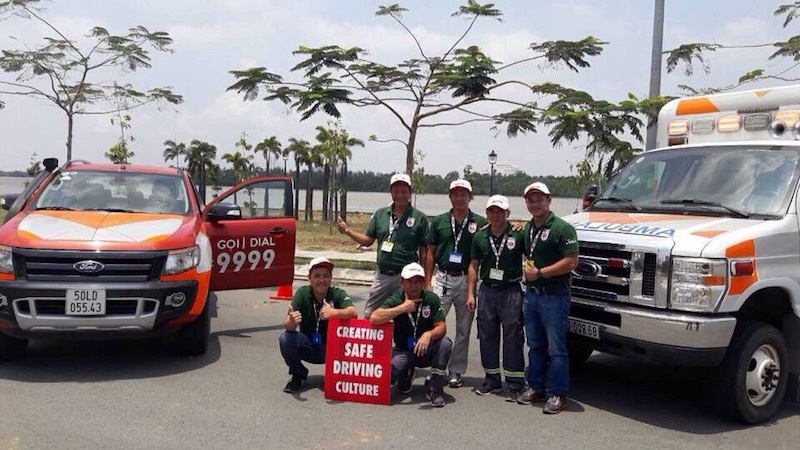With increasing volumes of traffic coming in to Ho Chi Minh City on a daily basis, Family Medical Practice has recently made efforts to address driver safety on our roads. Last month, as a part of this initiative, International Road Safety Specialist (MPH) Roy Ben Eliezer was invited to give advanced training to all EMR *9999 ambulance drivers. In the following article, Roy discusses why driver safety is already a major focus of international organizations.
In case you hadn’t heard, we’re currently living in the United Nations Decade of Action for Road Safety, 2011–2020. This is a worldwide campaign that was launched to call on all state members to follow the work plan and guidelines that the UN delivers throughout its term.
This UN initiative was set up to address the staggering number of traffic fatalities that occur every year—1.3 million people around the world. This silent epidemic is steadily climbing the ranks of issues causing concern to the point where the W.H.O. now predicts that by 2030, traffic accidents and injury prevention will surpass tuberculosis, malaria and HIV/ AIDS as a focus of activity.
The United Nations campaign dictates five pillars that require attention. Pillar number one is road safety management, while pillar number two covers safer roads and mobility—everything that has to do with infrastructure in order to build safer roads, sidewalks, traffic overpasses, and green mobility solutions that are affordable to all people.
Pillar number three discusses safer vehicles. In 2011, for instance, the people of Myanmar drove a lot of very old cars, hardly any of which had a seatbelt, BS emission standards, or an airbag. The government passed a resolution to offer tax waivers to drivers upgrading their vehicles—so everybody scrapped their cars, bought lots of Toyotas and secondhand cars from Japan, and everyone benefited from having safer vehicles.
Pillar number four talks about safer road users, reaching out to people from kindergarten, to university, to the workplace—training the drivers, teaching the students, and working with vulnerable communities as a whole to improve the awareness and the understanding of road users (including pedestrians, cyclists, drivers and so on).
Pillar number five is most closely related to emergency medicine & trauma services, talking about postcrash care. The goal is to enhance and better respond to emergency and trauma injuries resulting from traffic accidents. In this instance, the focus is what we call the “golden hour,” the first sixty minutes taken to arrive at the scene, stabilize the patient, mobilize him, and transfer him to the nearest medical facility where somebody, a clinician or doctor, can pay further attention to his injuries.
The Human Factor
When creating a safe driving culture, it’s important to focus on the human factor in accident prevention. There are considered to be four factors contributing to accidents—human, infrastructure, environmental, and the vehicles themselves. One prevailing school of thought holds that the human factor accounts for more than ninety percent of the cause of traffic accidents. At the end of the day, it’s drivers who use their mobile phone, adjust the radio, look outside, eat and drink, talk to passengers or consume alcohol. All these things serve to affect and distract a driver. The human element is involved in the other factors also—if the vehicle is not well-maintained, it’s your responsibility to check the engine oil; if the environmental conditions are rainy or stormy, just don’t drive, or otherwise take precautions. If the road is not wellmaintained, then slow down! The most critical imperative here is to change people’s mindsets.
The methodologies used in training drivers are now relatively modern. They include innovative simulations, some defensive driving theory, practice, exercises, and presentations. It’s not really enough to teach people the basics of safe driving and drive them around a training course a few times—sometimes the most effective way to change safety conditions on the road is to change people’s minds.
An excellent case study on this point is actually from Vietnam, which is is often held up as an example throughout the region. This concerns the 2007 helmet law. Since this law passed, we have seen a significant reduction not only in fatalities but also in serious injuries during road accidents.
A 2007 report shows that there were close to thirteen thousand people dying on the road every year in Vietnam before the law was implemented. And then, from 2008, the numbers started to go down. Naturally, it’s not all related to the helmet law, which was complemented by education and enforcement. Part of the success is due to the social marketing that the W.H.O. and all the international agencies put out here in Vietnam, because they found there were difficulties and challenges in reaching young people about wearing their helmet. “It ruins my hair,” they would say, or “it makes me look stupid.” What looks more stupid? To wear a helmet, or to be fed by a spoon for the rest of your life by your mother or grandma? A messed-up hairstyle, or a scalp carved up with ugly operation scars?
Stopping = Braking + Thinking
Of course, practical sessions are still very important in safety training. To teach the basic fundamentals, the prerequisite is vehicle control and emergency braking. Not many drivers here, even professional ones, have ever experienced on their own or within any other framework the techniques of emergency braking. In one-on-one training, an instructor should give students a cue to brake, and they would have to squeeze the brake immediately in order to overcome any fear they have—the message is that “you control the vehicle, not the other way around.”
Second, it’s important to understand that braking distance and stopping distance are not the same thing—because stopping distance involves both braking itself and thinking about braking. Every fraction of a second is important and every meter is important, because if you are distracted, the longer your braking or stopping distance will be.
If you’re drunk or are distracted, then your response time as a driver will slow down, and you may hit someone. The bottom line is always, “When you drive, drive. Don’t do anything else.”

EMR *9999 is a world-class emergency responder service available in Ho Chi Minh City. In putting safety standards first, *9999 addresses every aspect of emergency response, from delivering immediate medical advice via phone to supporting incidents with state-of-the-art ambulances and on-board equipment manned by a professional medical team. Ambulance drivers are also trained to assist in emergencies, with their most important role being to swiftly deliver patients to a medical facility while staying on top of road safety. For more information, visit www.star9999.vn.
Roy Ben Eliezer is the co-founder and COO of the Interdisciplinary Center for Road Safety (ICRS). He recently served to train ambulance drivers in advanced driving techniques for EMR *9999 emergency responders in Saigon. Learn more about the ICRS at www.icroadsafety.com.
Accidents in Vietnam
- In 2017 there were 20,000 accidents causing 8,300 deaths and 17,000 injuries.
- Vietnam traffic fatality rate is 245/100,000 – SEA’s second highest after Thailand.
- In 2016 there were 62 accidents classified as extremely serious, resulting in a total of 200 deaths. In 2017, that figure rose to 70 cases with 224 fatalities.
- Of the 144 most widely-reported accidents between 2013-2017, men were responsable for 98,61%. Women account for one third of the accidents’ victims
Statistics from Vietnamnews.vn




